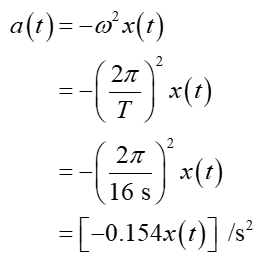Problem Ten. An object in simple harmonic motion is described by the figure. x (cm) 4.00 Find the acceleration (in cm/s²) when t = 6.80 s. (B) 0.732 (E) 4.52 (C) 0.550 2.00 22.) (A) 1.59 (D) 2.97 0.00 t (s) Find the time (in s) when the position is a quarter of the amplitude. -2.00 -4.00 23.) (A) 7.56 (D) 3.36 (B) 0.56 (E) 4.52 (C) 1.18 If the graph represents a pendulum, find how long the pendulum is in meters. 24.) (A) 82.5 (В) 49.9 (C) 157 (D) 39.7 (E) 63.5 If the graph represents a 20.0 kg mass on a spring, find the spring constant in N/m. 25.) (A) 15.2 (B) 8.67 (C) 3.08 (D) 2.47 (E) 5.46
Problem Ten. An object in simple harmonic motion is described by the figure. x (cm) 4.00 Find the acceleration (in cm/s²) when t = 6.80 s. (B) 0.732 (E) 4.52 (C) 0.550 2.00 22.) (A) 1.59 (D) 2.97 0.00 t (s) Find the time (in s) when the position is a quarter of the amplitude. -2.00 -4.00 23.) (A) 7.56 (D) 3.36 (B) 0.56 (E) 4.52 (C) 1.18 If the graph represents a pendulum, find how long the pendulum is in meters. 24.) (A) 82.5 (В) 49.9 (C) 157 (D) 39.7 (E) 63.5 If the graph represents a 20.0 kg mass on a spring, find the spring constant in N/m. 25.) (A) 15.2 (B) 8.67 (C) 3.08 (D) 2.47 (E) 5.46
Related questions
Question

Transcribed Image Text:Problem Ten. An object in simple harmonic motion is
described by the figure.
x (cm)
4.00
Find the acceleration (in cm/s²) when t = 6.80 s.
(B) 0.732
(E) 4.52
(C) 0.550
2.00
22.) (A) 1.59
(D) 2.97
0.00
t (s)
Find the time (in s) when the position is a quarter of
the amplitude.
-2.00
-4.00
23.) (A) 7.56
(D) 3.36
(B) 0.56
(E) 4.52
(C) 1.18
If the graph represents a pendulum, find how long the pendulum is in meters.
24.) (A) 82.5
(В) 49.9
(C) 157
(D) 39.7
(E) 63.5
If the graph represents a 20.0 kg mass on a spring, find the spring constant in N/m.
25.) (A) 15.2
(B) 8.67
(C) 3.08
(D) 2.47
(E) 5.46
Expert Solution
Step 1
(22) Acceleration in simple harmonic motion

The position at time t = 6.80 s is between -2 cm and -4 cm. Thus, the acceleration at time t is in the range, 0.308 cm/s2 and 0.617 cm/s2. Thus, the correct option is (c) 0.550
Step 2
(23) Amplitude (from the graph) is 4.00 cm. Quarter of the amplitude is 1.00 cm. From, the graph, a position of 1.00 cm is in the range 3s to 4s. Thus, the correct option is (d) 3.36
Step by step
Solved in 4 steps with 3 images
